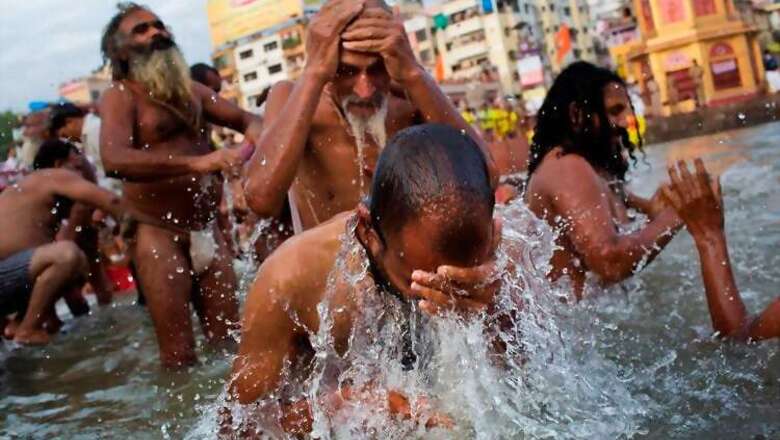
views
Dreadlocked Indian holy men and waves of Hindu pilgrims washed away their sins with a religious dip on the first main bathing day of India's massive Kumbh Mela festival on Saturday.
The sadhus, or "Godmen", naked and with their faces painted, danced and chanted as they jumped into a holy ghat at a temple in the western Indian state of Maharashtra.
Tens of thousands celebrated the Shahi Snan, meaning "royal bath", with Hindu sects following one another in shedding their orange robes before splashing joyously into the sacred water at Nashik.
Their time to bathe lasted just seconds, however, as hundreds of police officers frantically blew their whistles to signal for them to hastily make way for the next wave of devotees.
The Kumbh Mela a celebration of faith in which Hindus bathe in a sacred river is held every third year and is rotated between four holy sites.
As a result, it takes place at Nashik every 12 years and although it isn't on the same scale as the editions on the Ganges at Haridwar and the Saraswati at Allahabad, it still draws millions of pilgrims.
Organisers had increased safety measures in a bid to avoid a repeat of a deadly stampede at the same venue 12 years ago, and said the mass bathe had so far passed without major incident.
"No, nothing like that, it all went well," K. Moghe, the district information officer for Nashik, said.
Thirty-nine pilgrims were trampled to death when the religious festival was last held on the banks of the Godavari river in Nashik, around 160 kilometres (100 miles) from Mumbai, in 2003.
The crush was believed to have been triggered when a sadhu, or holy man, threw coins into a crowd of pilgrims who were growing increasingly impatient at having to wait for their turn to bathe.
When the coins were thrown they scrambled to gather them, resulting in dozens of people suffocating, according to reports at the time.
Nashik is unique out of the four venues in that it has two main bathing sites, the Godavari river in Nashik and nearby Trimbakeshwar temple ghat, stretching the emergency services across a wide area.
For this year's edition, officials changed the routes to the ghats to avoid steep slopes while a massive police presence of around 20,000 officers ensured little overcrowding and first aid workers stood ready.
The first sadhus entered the water at Trimbakeshwar shortly before 4:00 am with a continuous flow of devotees rejoicing in the ghat for several hours afterwards.
The Kumbh Mela has its origins in Hindu mythology, which describes how a few drops of the nectar of immortality fell on all of the places that host the festival, the fourth being Ujjain in central India.
Between eight and 10 million pilgrims are expected to attend the two-month-long Hindu festival this year. Its official opening was marked with a low-key flag raising ceremony in Nashik on July 14. There are two main bathing dates left, on September 13 and September 18


















Comments
0 comment